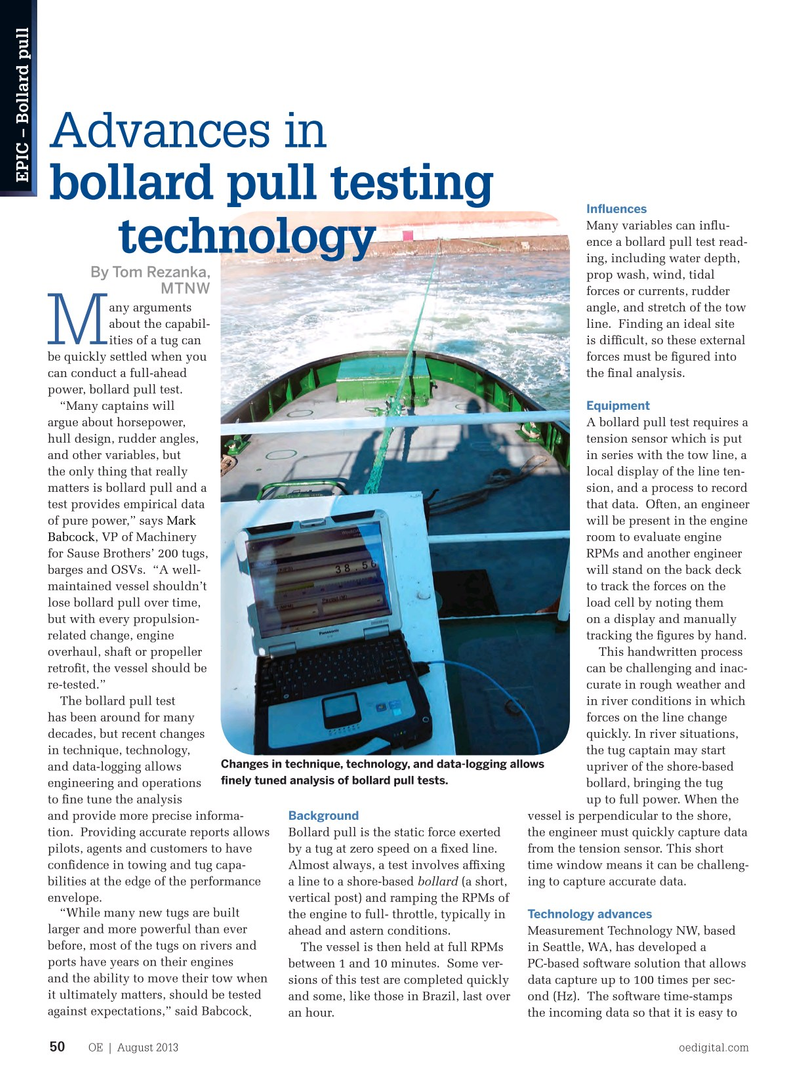
Page 48: of Offshore Engineer Magazine (Aug/Sep 2013)
Read this page in Pdf, Flash or Html5 edition of Aug/Sep 2013 Offshore Engineer Magazine
Advances in
EPIC – Bollard pull bollard pull testing
Infuences
Many variables can infu- ence a bollard pull test read- technology ing, including water depth,
By Tom Rezanka, prop wash, wind, tidal
MTNW forces or currents, rudder any arguments angle, and stretch of the tow about the capabil- line. Finding an ideal site ities of a tug can is diffcult, so these external
M be quickly settled when you forces must be fgured into can conduct a full-ahead the fnal analysis.
power, bollard pull test. “Many captains will
Equipment argue about horsepower, A bollard pull test requires a hull design, rudder angles, tension sensor which is put and other variables, but in series with the tow line, a the only thing that really local display of the line ten- matters is bollard pull and a sion, and a process to record test provides empirical data that data. Often, an engineer of pure power,” says Mark will be present in the engine
Babcock, VP of Machinery room to evaluate engine for Sause Brothers’ 200 tugs, RPMs and another engineer barges and OSVs. “A well- will stand on the back deck maintained vessel shouldn’t to track the forces on the lose bollard pull over time, load cell by noting them but with every propulsion- on a display and manually related change, engine tracking the fgures by hand.
overhaul, shaft or propeller This handwritten process retroft, the vessel should be can be challenging and inac- re-tested.” curate in rough weather and
The bollard pull test in river conditions in which has been around for many forces on the line change decades, but recent changes quickly. In river situations, in technique, technology, the tug captain may start
Changes in technique, technology, and data-logging allows and data-logging allows upriver of the shore-based fnely tuned analysis of bollard pull tests.
engineering and operations bollard, bringing the tug to fne tune the analysis up to full power. When the and provide more precise informa- vessel is perpendicular to the shore,
Background tion. Providing accurate reports allows Bollard pull is the static force exerted the engineer must quickly capture data pilots, agents and customers to have by a tug at zero speed on a fxed line. from the tension sensor. This short confdence in towing and tug capa- Almost always, a test involves affxing time window means it can be challeng- bilities at the edge of the performance a line to a shore-based bollard (a short, ing to capture accurate data.
envelope. vertical post) and ramping the RPMs of “While many new tugs are built the engine to full- throttle, typically in
Technology advances larger and more powerful than ever ahead and astern conditions. Measurement Technology NW, based before, most of the tugs on rivers and
The vessel is then held at full RPMs in Seattle, WA, has developed a ports have years on their engines between 1 and 10 minutes. Some ver- PC-based software solution that allows and the ability to move their tow when sions of this test are completed quickly data capture up to 100 times per sec- it ultimately matters, should be tested and some, like those in Brazil, last over ond (Hz). The software time-stamps against expectations,” said Babcock. an hour. the incoming data so that it is easy to
OE | August 2013 oedigital.com 50 050_OE0813_EPIC2_BollardPull.indd 50 7/22/13 12:38 AM

 47
47

 49
49